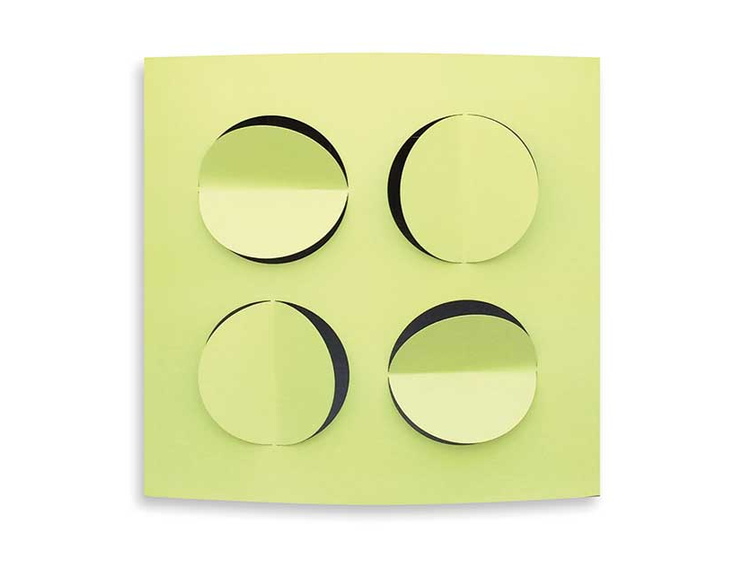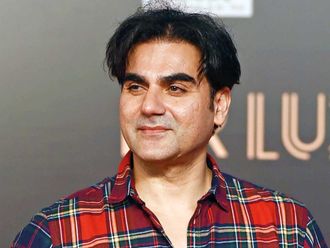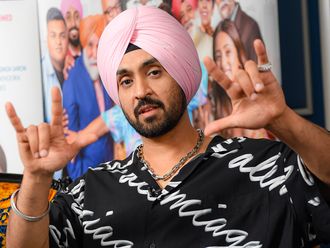Ayyam Gallery Dubai is presenting a solo exhibition by Rashid Al Khalifa, a key figure of contemporary art in the Kingdom of Bahrain. The show, titled Hybrids, features a selection of wall-mounted installations from seven different series created between 2010 and 2017. The artist has used enamel paints on steel and aluminum panels to create these hybrids of painting and sculpture that are subtle, serene and profound.
Al Khalifa belongs to the royal family of Bahrain. He was born in 1952 and studied art and design at the Brighton and Hastings Art College in the UK. He was the first president of the Bahrain Arts Society and continues to be its honorary president. After experimenting with different styles such as impressionism, realism and abstract expressionism, he gradually moved towards the language of geometric abstraction and colour field.
In the 1990s, his exploration of deconstructing the picture frame led him to start painting on a canvas that was stretched by 25 degrees to form a convex shape. He developed this further by replacing the canvas with materials such as wood, steel and aluminum and using matte or lacquered enamel instead of oil and acrylic paints to create his unique hybrids that play with form, colour, texture, light and reflection.
His Convex series from 2010 features a bright circle painted with lacquered enamel in the centre of a convex square black aluminum base, crisscrossed by flowing lines of thick black paint. In later series, named Reflection and In Dialogue, the circle and lines are painted on chrome plated stainless steel.
“The lines in these works are the threads that represent people of different backgrounds from which the fabric of society is woven. I wanted to use steel because it acts as a mirror reflecting the viewers and making them part of the work. Through reflection, it also incorporates fragments from the environment into the work, inviting viewers to contemplate their perceptions about themselves and their surroundings,” the artist says.
In the series titled Into a Different Dimension, Al Khalifa added a new spatial dimension to his work by cutting out a circular hole in the centre of the convex aluminum and steel bases, drawing viewers in to delve deeper within the layers. While some of these layered works are monochromatic, others are covered with fields of pastel shades.
Rashid Al Khalifa, Untitled, Shape of Time series, 2015, matte enamel on aluminium.
The artist has tried to bring in the fourth dimension of time in the Shape of Time series, featuring tiny circular cutouts arranged in grids on metal panels. At the two points of attachment to the base, the circles are turned at different angles or slightly folded. This imparts a kinetic feel to the works reflecting the movement of the earth, sun and moon and the continuum of time from day to night, and from one season to another. Each opening in the grid seems like a mystical portal into an unknown time and space.
In his most recent series Flora and Waves the circles are missing. In Flora they are transformed into flowers. In Waves, the artist has used two curved aluminum panels coated with different enamel colours to create the feel of a wave, taking his exploration of painting, design, architecture and the relationship between the viewer and the work in a new direction.
The duality between light and dark, reality and reflection, truth and perception, explored in his earlier works now appears as the duality between sea and shore, creation and destruction as the waves form and crash on the sand. And once again, the dark space between the two halves beckons viewers for an adventure into the unknown.
“Whether it be through how we reconstruct and interpret what we see or how our minds parse the information that will enable us to explain and understand what we are seeing, my artwork is a form of communication and sensorial engagement for self-exploration, for myself and the viewer,” Al Khalifa says.
The artist has created a special floral version of his work, featuring a white panel with a big circle filled with fresh red roses placed on the wall at the entrance of the gallery.
“I am very happy to exhibit my work in Dubai, a city which is like my second home and this is my way of saying thank you. Dubai is an international art hub no less important than New York, London, Paris, Berlin and Hong Kong and I feel there could be no better place to show my work,” he says.
Hybrids will run at Ayyam gallery Dubai, Alserkal Avenue, Al Quoz,until March 10.














